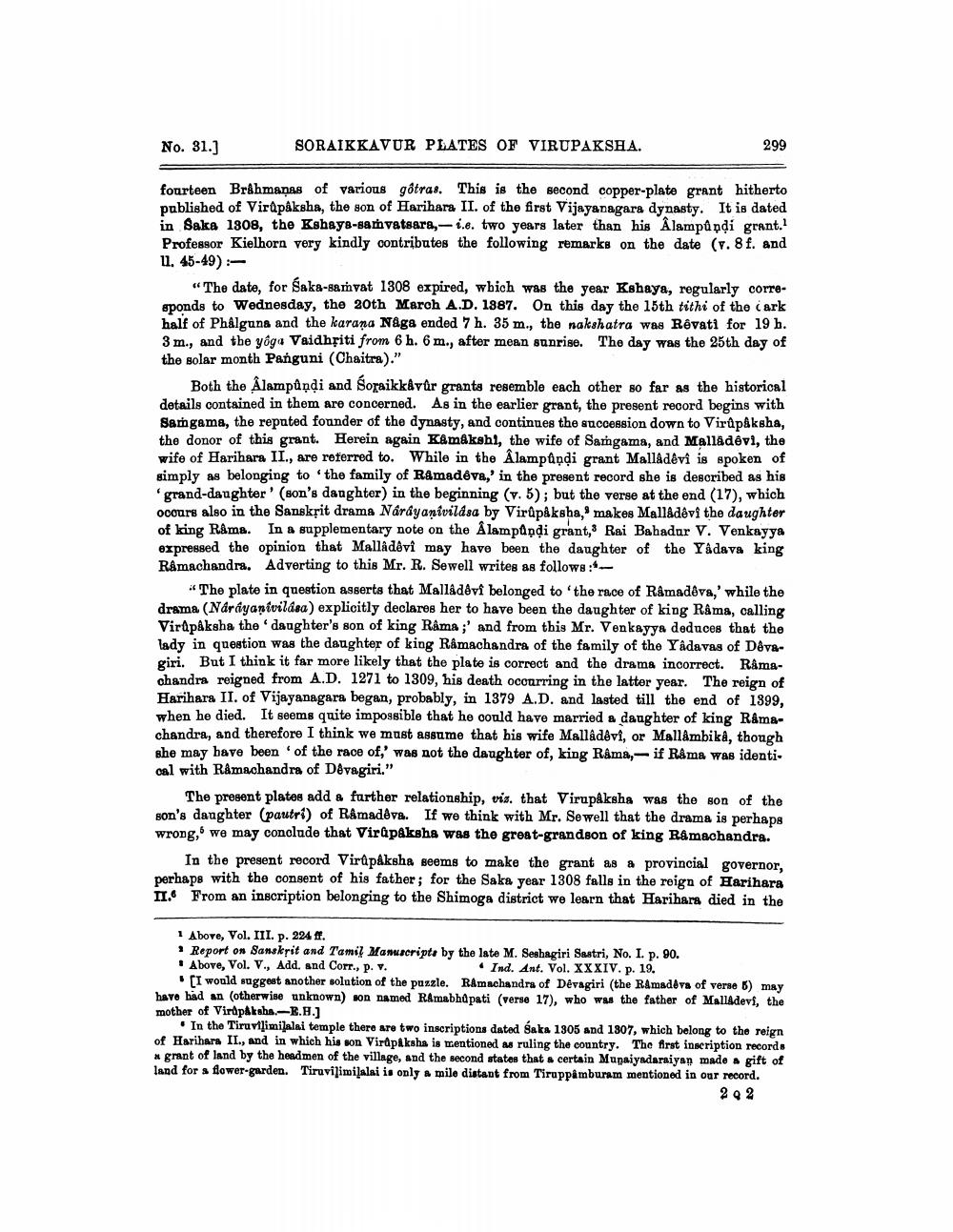________________
SORAIKKAVUR PLATES OF VIRUPAKSHA.
No. 31.]
fourteen Brahmanas of various gôtras. This is the second copper-plate grant hitherto published of Virupaksha, the son of Harihara II. of the first Vijayanagara dynasty. It is dated in Saka 1308, the Kshaya-samvatsara,-i.e. two years later than his Âlampânḍi grant.1 Professor Kielhorn very kindly contributes the following remarks on the date (v. 8 f. and 11. 45-49):
299
"The date, for Saka-samvat 1308 expired, which was the year Kshaya, regularly corresponds to Wednesday, the 20th March A.D. 1887. On this day the 15th tithi of the cark half of Phalguna and the karana Någa ended 7 h. 35 m., the nakshatra was Rêvati for 19 b. 3 m., and the yoga Vaidhriti from 6 h. 6 m., after mean sunrise. The day was the 25th day of the solar month Panguni (Chaitra)."
Both the Âlampunḍi and Soraikkâvûr grants resemble each other so far as the historical details contained in them are concerned. As in the earlier grant, the present record begins with Samgama, the reputed founder of the dynasty, and continues the succession down to Virupaksha, the donor of this grant. Herein again Kamakshi, the wife of Samgama, and Malladevi, the wife of Harihara II., are referred to. While in the Âlampânḍi grant Mallâdêvî is spoken of simply as belonging to the family of Ramadeva,' in the present record she is described as his 'grand-daughter' (son's daughter) in the beginning (v. 5); but the verse at the end (17), which occurs also in the Sanskrit drama Nárayanivilása by Virupaksha, makes Mallâdêvî the daughter of king Râma. In a supplementary note on the Âlampunḍi grant, Rai Bahadur V. Venkayya expressed the opinion that Mallâdêvî may have been the daughter of the Yadava king Ramachandra. Adverting to this Mr. R. Sewell writes as follows:
The plate in question asserts that Mallâdêvî belonged to 'the race of Râmadêva,' while the drama (Nárayantvilása) explicitly declares her to have been the daughter of king Râma, calling Virupaksha the daughter's son of king Râma;' and from this Mr. Venkayya deduces that the lady in question was the daughter of king Ramachandra of the family of the Yâdavas of Devagiri. But I think it far more likely that the plate is correct and the drama incorrect. Râmachandra reigned from A.D. 1271 to 1309, his death occurring in the latter year. The reign of Harihara II. of Vijayanagara began, probably, in 1379 A.D. and lasted till the end of 1399, when he died. It seems quite impossible that he could have married a daughter of king Râmachandra, and therefore I think we must assume that his wife Mallâdêvi, or Mallâmbika, though she may have been of the race of,' was not the daughter of, king Râma,- if Rama was identi. cal with Ramachandra of Devagiri."
The present plates add a further relationship, viz. that Virupaksha was the son of the son's daughter (pautri) of Ramadeva. If we think with Mr. Sewell that the drama is perhaps wrong," we may conclude that Virupaksha was the great-grandson of king Ramachandra.
In the present record Virupaksha seems to make the grant as a provincial governor, perhaps with the consent of his father; for the Saka year 1308 falls in the reign of Harihara II. From an inscription belonging to the Shimoga district we learn that Harihara died in the
1 Above, Vol. III. p. 224 ff.
Report on Sanskrit and Tamil Manuscripts by the late M. Seshagiri Sastri, No. I. p. 90. Above, Vol. V., Add. and Corr., p. v. Ind. Ant. Vol. XXXIV. p. 19.
[I would suggest another solution of the puzzle. Ramachandra of Devagiri (the Ramadeva of verse 5) may have had an (otherwise unknown) son named Ramabhupati (verse 17), who was the father of Malladevi, the mother of Virapaksha.-E.H.]
In the Tiruvilimilalai temple there are two inscriptions dated saka 1305 and 1307, which belong to the reign of Harihara II., and in which his son Virupaksha is mentioned as ruling the country. The first inscription records a grant of land by the headmen of the village, and the second states that a certain Munaiyadaraiyan made a gift of land for a flower-garden. Tiruvilimilalai is only a mile distant from Tiruppâmburam mentioned in our record.
202




